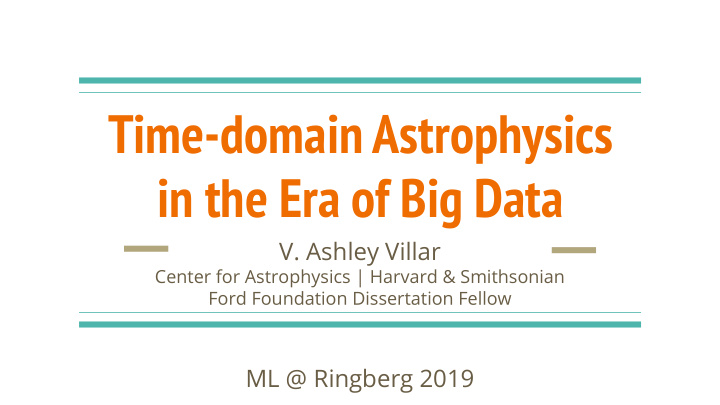



Time-domain Astrophysics in the Era of Big Data V. Ashley Villar Center for Astrophysics | Harvard & Smithsonian Ford Foundation Dissertation Fellow ML @ Ringberg 2019
Transients connect to all branches of astrophysics HST Soares-Santos+2017 L. Singer Scolnic+ 2018 How does the zoo of observed transients connect with the underlying (astro)physics?
Type Ia Supernova Time w/ offset (Days)
SNe powered by 56Ni Radioactive Decay ashleyvillar.com/dlps
VAV+ 2017a
The Large Synoptic Survey Telescope LSST
LSST will discover >1 million supernovae annually! LSST ~10 6 2023 Data from OSC; Guillochon+ 2018
We will follow up some of these supernovae ~1000s of spectra 2023 Data from OSC; Guillochon+ 2018
The LSST Needles & the Haystack ~100 SNe we actively follow with other resources ~1000s / Year With spec. classification ~Million SNe / Year
A Christmas list for SN classification: 1. Meaningful feature extraction which can handle noisy, sparse data 2. Feature extraction which can utilize unclassified data 3. Classification which can work on incoming data 4. A method which can search for needles in real time
A Christmas list for SN classification: 1. Meaningful feature extraction which can handle noisy, sparse data 2. Feature extraction which can utilize unclassified data 3. Classification which can work on incoming data 4. A method which can search for needles in real time Recurrent neuron-based autoencoder
Pan-STARRS Medium Deep Survey is a milliLSST ● ~5200 SNe-like transients in PS1 MDS (Jones+2017) ● ~3200 SNe have host redshift measurements ● ~520 SNe are spectroscopically classified with host redshift measurements Chambers+ 2016
A semi-supervised method to encode/classify SNe 1x10 T x 4 x 3 Time, flux, error Encoded LC Encoder Decoder VAV + in prep.
Use a GP to deal with uneven sampling in filters
Recurrent neurons update the encoded light curve Input: [T, F g , F r , F i , F z , σ g , σ r , σ i , σ z ] state h Encoding
Repeat encoded LC with a new set of times 1x10 ... t1 t2 t3 t4 tn Encoded LC Decoder VAV + in prep.
Decoded light curve updated with new data VAV + in prep.
Decoded light curve updated with new data VAV + in prep.
Decoded light curve updated with new data VAV + in prep.
Decoded light curve updated with new data VAV + in prep.
Decoded light curve updated with new data VAV + in prep.
Why use a RNN autoencoder? ● Semi-supervised methods allow us to use information from the full dataset ● We can extract unique, nonlinear features directly from the light curves ● Actively makes forecasting predictions, which may be used to hunt for anomalies aka the needles
Using a random forest classifier, we classify the full sample of 3200 SNe VAV + in prep.
Time-domain Astrophysics in the Era of Big Data LSST will bring TDA into a new era of big data, thanks to both a deep and ● wide survey strategy LSST light curves will be noisy and sparse, but simple features correlate ● with underlying physics RNN-based AEs are a promising strategy to classify SNe in real time ● RNN-based AEs may be a promising strategy for real time anomaly ● detection
CLASSIFICATION RAPID P E L I C A N W a v e l e t d e c o m p o s i t i o n Online learning avocado High Ia purity! P L A s T i C C SNPCC I m a g e - b a s e d C N N https://tinyurl.com/transienttable
Do we have a suitable training set for classification? PLAsTiCC Real datastream! Simulated dataset gr(i) filters LSST filters/cadence Depth ~21 mag see e.g., Bellm+ 2019; Kessler+ 2019
Recommend
More recommend